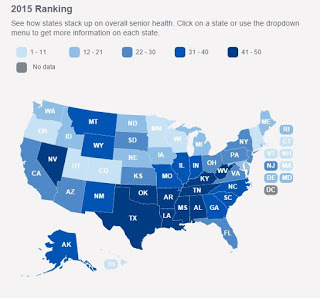Kentucky’s seniors rank 48th in insurance firm’s health rankings

 |
| Click here to go to interactive map. |
Kentucky seniors ranked in the bottom 10 states for 23 of the 35 measures ranked by the 2015 America’s Health Ranking Seniors Report, placing Kentucky in 48th place for the second year in a row.
“The report is a call to action. We believe you can’t improve what you don’t measure,” Dr. Julie Daftari, market medical director for United Health Care of Kentucky told Alyssa Harvey of the Bowling Green Daily News. “It may start with seniors taking individual action. If we live long enough, we’ll be part of these statistics in the future.”
 The report notes that smoking is the leading cause of preventable death in the U.S. and “older smokers are at an increased risk of smoking-related illness as they tend to be heavy smokers with an average smoking duration of 40 years” and “are less likely than younger smokers to believe that smoking harms their health.” Kentucky, with 11.8 percent of its seniors regularly smoking, ranked third highest in senior smoking, behind Nevada and Mississippi.
The report notes that smoking is the leading cause of preventable death in the U.S. and “older smokers are at an increased risk of smoking-related illness as they tend to be heavy smokers with an average smoking duration of 40 years” and “are less likely than younger smokers to believe that smoking harms their health.” Kentucky, with 11.8 percent of its seniors regularly smoking, ranked third highest in senior smoking, behind Nevada and Mississippi.
The report is intended to point out the health challenges facing today’s seniors and offer a starting point to help states determine what needs to change. That being said, Kentucky ranks very low in an area that could help improve these outcomes: community support, where it ranks 45th.
The report did say that Kentucky seniors do have some strengths. They have a low prevalence of chronic drinking, low percentage of adults needing pain management, high flu vaccination coverage and a low percentage of low-care nursing home residents.
More Kentucky seniors also reported very good or excellent health since last year’s report, up to 33.7 percent from 31.2 percent.
The report noted that a decrease in physical inactivity is a nationwide problem for seniors, with 33.1 percent of seniors nationwide reporting they did not get enough physical activity. This percentage was even higher in Kentucky at 40.2 percent, which is higher than the previous two years (34.5 percent in 2014 and 17 percent in 2013).
 The report notes that today, one in seven Americans are aged 65 and older, and in the next two decades the rest of the 77 million baby boomers will move into this demographic. The report also projected the increase in Kentucky’s senior population between 2015 to 2030 will be 41.8 percent.
The report notes that today, one in seven Americans are aged 65 and older, and in the next two decades the rest of the 77 million baby boomers will move into this demographic. The report also projected the increase in Kentucky’s senior population between 2015 to 2030 will be 41.8 percent.
“The fact that we were able to identify key strengths and challenges gives Kentucky an opportunity to address those specific issues,” Daftari told Harvey. “If these challenges aren’t addressed, there may be a significant strain on health care in the future.”
The rankings were based on 35 measures of senior health including behavior determinants like smoking and dental visits; micro and macro community and environmental determinants like poverty and social support; policy issues like percentage of seniors on SNAP; and measures of clinical care like the percentage of seniors who receive home health.; and outcomes like the percentage of seniors who have fallen. It also included measures like education and cognition.